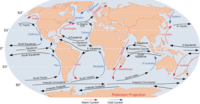
Photo from wikipedia
Determination of the rate of change of sea surface CO2 fugacity (fCO2) is important, as the fCO2 gradient between the atmosphere and the ocean determines the direction of CO2 flux… Click to show full abstract
Determination of the rate of change of sea surface CO2 fugacity (fCO2) is important, as the fCO2 gradient between the atmosphere and the ocean determines the direction of CO2 flux and hence the fate of this greenhouse gas. Using a newly available, community-based global CO2 database (Surface Ocean CO2 Atlas Version 3 coastal data set) and a newly developed statistical method, we report that the global ocean margins (within 400 km offshore, 30°S–70°N) fCO2 temporal trends on decadal time scales (1.93 ± 1.59 μatm yr−1) closely follow the atmospheric fCO2 increase rate (1.90 ± 0.06 μatm yr−1) in the Northern Hemisphere but are lower (1.35 ± 0.55 μatm yr−1) in the Southern Hemisphere, reflecting dominant atmospheric forcing in conjunction with different warming rates in the two hemispheres. In addition to the atmospheric fCO2 forcing, a direct warming effect contributes more to fCO2 increase in the western boundary current-influenced areas, while intensified upwelling contributes more to fCO2 increase in eastern boundary current-influenced areas.
Journal Title: Geophysical Research Letters
Year Published: 2017
Link to full text (if available)
Share on Social Media: Sign Up to like & get
recommendations!